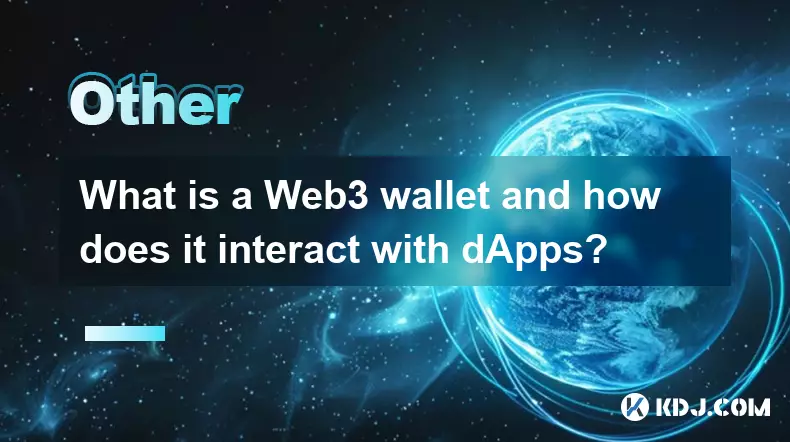-
 bitcoin
bitcoin $102182.982207 USD
-0.92% -
 ethereum
ethereum $3438.744518 USD
0.12% -
 tether
tether $0.999933 USD
0.02% -
 xrp
xrp $2.405093 USD
0.05% -
 bnb
bnb $956.306114 USD
-0.53% -
 solana
solana $153.028851 USD
-1.23% -
 usd-coin
usd-coin $0.999800 USD
-0.03% -
 tron
tron $0.294898 USD
-1.08% -
 dogecoin
dogecoin $0.171428 USD
-0.58% -
 cardano
cardano $0.551186 USD
-1.15% -
 hyperliquid
hyperliquid $38.755878 USD
0.04% -
 chainlink
chainlink $15.298460 USD
-0.05% -
 bitcoin-cash
bitcoin-cash $516.067428 USD
1.68% -
 stellar
stellar $0.280726 USD
-0.42% -
 zcash
zcash $518.919369 USD
18.01%
What is a Web3 wallet and how does it interact with dApps?
A Web3 wallet securely connects you to dApps by managing private keys and enabling blockchain interactions without sharing sensitive data.
Nov 09, 2025 at 02:40 pm

Understanding Web3 Wallets
1. A Web3 wallet is a digital tool that enables users to interact with blockchain networks, particularly those supporting decentralized applications (dApps). Unlike traditional wallets that only store cryptocurrencies, Web3 wallets manage private keys and facilitate secure interactions with smart contracts.
2. These wallets come in various forms such as browser extensions (e.g., MetaMask), mobile apps (e.g., Trust Wallet), or hardware devices (e.g., Ledger). Each type ensures the user retains full control over their assets without relying on centralized intermediaries.
3. The core function of a Web3 wallet is identity management. When a user connects to a dApp, the wallet acts as a personal identity layer, authenticating actions through cryptographic signatures without exposing private keys.
4. Transactions initiated through dApps—like swapping tokens, staking, or voting in DAOs—are signed locally within the wallet. This means no third party ever has access to sensitive credentials, enhancing security across decentralized platforms.
5. Web3 wallets support multiple blockchains and token standards (ERC-20, ERC-721, etc.), enabling seamless interaction across ecosystems like Ethereum, Polygon, and Binance Smart Chain.
How Web3 Wallets Connect to dApps
1. When a user visits a dApp website, they are typically prompted to connect their wallet via a “Connect Wallet” button. This triggers a secure handshake between the dApp’s frontend and the wallet interface.
2. Upon connection, the wallet shares only the user’s public address with the dApp. No private information is transmitted during this process, preserving privacy and reducing attack surface.
3. Once connected, the dApp can read blockchain data associated with the user’s address, such as token balances, NFT ownership, or participation history in DeFi protocols.
4. Any action requiring blockchain state changes—such as approving a token transfer or minting an NFT—must be explicitly confirmed by the user through their wallet interface. This confirmation involves signing a transaction using the private key stored securely in the wallet.
5. The signed transaction is then broadcasted to the network through a node provider (often integrated into the wallet infrastructure), where it gets validated and included in a block.
Security Considerations for Wallet-dApp Interaction
1. Users must remain cautious when connecting wallets to unfamiliar dApps. Malicious sites can request excessive permissions, including unlimited token approvals that expose funds to potential theft.
2. Phishing attacks often mimic legitimate dApps to trick users into connecting their wallets. Verifying URLs and using community-curated allowlists can reduce such risks significantly.
3. Some wallets now include built-in safeguards, like approval limit warnings or contract risk analysis, helping users detect suspicious behavior before confirming transactions.
4. Open-source transparency plays a crucial role. dApps with audited codebases and publicly verifiable smart contracts inspire greater trust among wallet users.
5. Regularly reviewing active permissions and revoking unnecessary token approvals through tools like revoke.cash enhances long-term security posture.
Frequently Asked Questions
What happens if I lose access to my Web3 wallet?Losing access usually means losing your recovery phrase or device. Without it, you cannot restore your wallet or recover assets. There is no central authority to reset access, emphasizing the importance of secure backup practices.
Can one Web3 wallet connect to dApps on different blockchains?Yes, many modern wallets support multi-chain functionality. By switching networks within the wallet settings, users can interact with dApps across various blockchains using the same address and key structure.
Do dApps store my private keys?No legitimate dApp ever stores or requests private keys. Private keys remain exclusively within the user’s wallet environment. dApps only receive transaction signatures generated by the wallet after user approval.
Is connecting a wallet to a dApp the same as logging in?While similar in user experience to traditional login systems, wallet connection is fundamentally different. It does not involve passwords or account creation. Instead, it establishes a temporary session based on cryptographic proof of ownership of an address.
Disclaimer:info@kdj.com
The information provided is not trading advice. kdj.com does not assume any responsibility for any investments made based on the information provided in this article. Cryptocurrencies are highly volatile and it is highly recommended that you invest with caution after thorough research!
If you believe that the content used on this website infringes your copyright, please contact us immediately (info@kdj.com) and we will delete it promptly.
- TRX Price & Tron's Resilience: Is the $EV2 Presale the Next Big Thing?
- 2025-11-13 17:00:02
- Sui's Stablecoin USDsui: Fueling the DeFi Ecosystem and Beyond
- 2025-11-13 17:30:01
- Meme Coins in the Hype Market: Utility vs. Virality in 2025
- 2025-11-13 16:55:01
- Bitcoin ATMs: Asia Heats Up as North America Faces Scrutiny
- 2025-11-13 17:20:01
- Crypto Payroll, Regulation, and Innovation: Navigating the New Frontier
- 2025-11-13 17:20:02
- Hakimi Meme Coin, Joyoung Soymilk, and BSC ROI: A Wild Ride in Crypto!
- 2025-11-13 17:30:02
Related knowledge

What are intents in crypto and how do they change user interaction?
Nov 09,2025 at 09:00am
Understanding the Role of Decentralized Exchanges in Modern Crypto Trading1. Decentralized exchanges, commonly known as DEXs, have reshaped how trader...

What is restaking and how does it enhance economic security?
Nov 09,2025 at 11:40pm
Understanding Restaking in the Blockchain Ecosystem1. Restaking refers to the process where users who have already staked their tokens in a proof-of-s...

What is a sovereign rollup and how does it differ from a smart contract rollup?
Nov 10,2025 at 09:00am
Understanding Sovereign Rollups1. A sovereign rollup operates as an independent blockchain layer that leverages the data availability of a base layer,...

What is a crypto-economic system and how does it use incentives to secure a network?
Nov 11,2025 at 01:20am
Understanding Crypto-Economic Systems1. A crypto-economic system refers to the integration of cryptography, distributed systems, and economic incentiv...

What is a blockchain's throughput and how is it measured?
Nov 12,2025 at 04:00am
Understanding Blockchain Throughput1. Blockchain throughput refers to the number of transactions a blockchain network can process within a specific ti...

What is the difference between a simple payment verification (SPV) node and a full node?
Nov 12,2025 at 09:40am
Understanding the Role of Full Nodes in the Blockchain Ecosystem1. A full node downloads and verifies every block and transaction in the blockchain ac...

What are intents in crypto and how do they change user interaction?
Nov 09,2025 at 09:00am
Understanding the Role of Decentralized Exchanges in Modern Crypto Trading1. Decentralized exchanges, commonly known as DEXs, have reshaped how trader...

What is restaking and how does it enhance economic security?
Nov 09,2025 at 11:40pm
Understanding Restaking in the Blockchain Ecosystem1. Restaking refers to the process where users who have already staked their tokens in a proof-of-s...

What is a sovereign rollup and how does it differ from a smart contract rollup?
Nov 10,2025 at 09:00am
Understanding Sovereign Rollups1. A sovereign rollup operates as an independent blockchain layer that leverages the data availability of a base layer,...

What is a crypto-economic system and how does it use incentives to secure a network?
Nov 11,2025 at 01:20am
Understanding Crypto-Economic Systems1. A crypto-economic system refers to the integration of cryptography, distributed systems, and economic incentiv...

What is a blockchain's throughput and how is it measured?
Nov 12,2025 at 04:00am
Understanding Blockchain Throughput1. Blockchain throughput refers to the number of transactions a blockchain network can process within a specific ti...

What is the difference between a simple payment verification (SPV) node and a full node?
Nov 12,2025 at 09:40am
Understanding the Role of Full Nodes in the Blockchain Ecosystem1. A full node downloads and verifies every block and transaction in the blockchain ac...
See all articles










































































